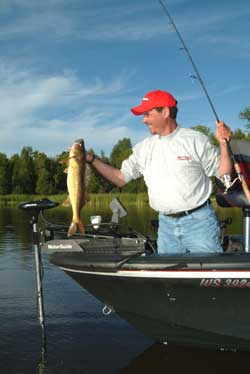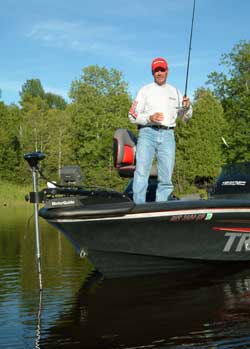 Many walleye anglers find mid-summer to be a time of “feast or famine” when it comes to catching fish. There’s little doubt that the walleyes’ activity level kicks into high gear with the summer temps and the abundance of food sources. The problem often lies in the fact that walleyes can adapt to so many environments making it tough to determine what pattern will put you on the most fish. There may be walleyes roaming the open waters of the main lake basin while others are hovering around rocky humps and reefs. There can be walleyes relating to deep structure, shallow flats or main lake points. But there’s one pattern that many anglers tend to bypass … walleyes in the weeds … and that’s a huge mistake.
Many walleye anglers find mid-summer to be a time of “feast or famine” when it comes to catching fish. There’s little doubt that the walleyes’ activity level kicks into high gear with the summer temps and the abundance of food sources. The problem often lies in the fact that walleyes can adapt to so many environments making it tough to determine what pattern will put you on the most fish. There may be walleyes roaming the open waters of the main lake basin while others are hovering around rocky humps and reefs. There can be walleyes relating to deep structure, shallow flats or main lake points. But there’s one pattern that many anglers tend to bypass … walleyes in the weeds … and that’s a huge mistake.
Not all lakes will harbor weed walleyes. This is a pattern primarily found in natural lakes since most reservoirs rarely contain any significant weed habitat, or at least not of the right type and density to hold any major population of walleyes. Natural lakes on the other hand typically offer plenty of weed habitat, and where there’s weeds there’s going to be fish.
Sparse weed patches or stands of sporadic reeds may look inviting and relatively easy to fish and that’s fine if you’re after species such as pike or muskie. But if its walleyes you’re after, you need to search out thicker weed beds. While a given lake may grow several types of weeds, the main ones a walleye angler should concentrate on locating are Coontail and Cabbage (a common name used for broad-leaf varieties such as Curlyleaf Pondweed). For what ever reason these types of weeds attract walleyes more than most other weed varieties, probably because they provide ample shade, grow in deeper water (as well as shallow), and provide cover for ambushing prey.
Most anglers think of finding weeds in their favorite lake by concentrating on the weed beds they can see … the ones in shallow water. That’s a good place to start, and weeds in water as shallow as two feet will hold walleyes as long as the water is stained or off-colored. In clear lakes however, the best weeds may grow in depths of twelve to twenty feet, and finding these requires a bit of searching with your electronics. This is one of those instances where the newer color style graph units like Lowrance’s LCX-111CHD really shine. The color screen really allows you to distinguish denser patches of deep weeds, and the higher power rating of a unit like the X-111 will even mark fish within the weeds.
But finding walleyes in the weeds is only half the battle … and usually the easiest half at that. One of the main reasons many anglers shy away from fishing weed walleyes is that getting them out of the weeds can often prove challenging. There are only a handful of presentation options that work effectively for jerking weed walleyes … and pitching a weedless jig probably tops the list.
Jigs designed for fishing in weeds are quite specialized. Examples such as Northland Tackle’s Weed Weasel or Lindy’s No-Snag Veg-E-Jig feature a compact, pointed head design and weed guards that couple to make these highly effective lures in snag infested habitats. To help improve hooking percentage we like to “condition” the weed guard by flexing it several times before putting it to use. This makes it easier for the walleye to mash down the weed guard when it takes the bait, decreasing the chances of missed fish. While bass anglers prefer heavier jigs for working weed cover, walleye jigs tend to be on the lighter side with one sixteenth and one eighth ounce models being the most popular.
 For tipping the jigs, leeches or minnows are top picks, but a half a nightcrawler makes a great jig dressing when the bite gets tough. Live bait is not required for successful catches however, and many times tipping the jig with plastics is actually more effective. Baits such as Berkley Power Grubs, Jerk Shads and Bungee Leeches are good choices. One of the deadliest jig dressings we’ve ever used is to thread half a GULP! Nightcrawler on the jig. These types of scent impregnated artificials are very effective for walleyes and much easier to keep than live bait on a hot summer day. One tip here: When fishing with plastics, it is often beneficial to go with a slightly heavier jig (one eighth to one quarter ounce) and give the lure a bit more “pop” on the retrieve. The enhanced action adds to the attraction and triggering capabilities of the presentation.
For tipping the jigs, leeches or minnows are top picks, but a half a nightcrawler makes a great jig dressing when the bite gets tough. Live bait is not required for successful catches however, and many times tipping the jig with plastics is actually more effective. Baits such as Berkley Power Grubs, Jerk Shads and Bungee Leeches are good choices. One of the deadliest jig dressings we’ve ever used is to thread half a GULP! Nightcrawler on the jig. These types of scent impregnated artificials are very effective for walleyes and much easier to keep than live bait on a hot summer day. One tip here: When fishing with plastics, it is often beneficial to go with a slightly heavier jig (one eighth to one quarter ounce) and give the lure a bit more “pop” on the retrieve. The enhanced action adds to the attraction and triggering capabilities of the presentation.
The key to this style of fishing is to keep the presentation as vertical as possible by making short, accurate casts to holes in the weeds or to irregularities along the weed edge. A simple underhand pitch-style cast works well for this. Be sure to allow the jig to fall straight down into the weeds before engaging the reel. If you don’t get bit right away, hop the jig a couple of times, then retrieve it and make another cast.
Equipping yourself to fish walleyes in the weeds is a little different from other jigging techniques. The same spinning reel you’d use for vertical jigging will do just fine, but we opt for a little heavier line such as eight pound test FireLine or eight pound test Berkley Sensation. This is also a situation where a longer rod comes in real handy. The Walleye Angler Signature Series model WX70MSH is our top choice. The seven foot medium action spinning rod helps in making accurate, pitching type casts and is just the right length for working the small jigs in and out of holes in the weeds. The extra length is also beneficial for getting good hook sets and pulling fish from cover.
Another great presentation for ousting walleyes from weed habitat is slip bobbering. Walleyes hunkered down in weeds are typically not very aggressive and a lively leech dangled right in front of their nose will, more often than not, get them to bite.
Jigs and slip bobbers work best in those situations when walleyes are right in the midst of a weed bed and the “vertical” style presentations are needed to root them out, but many times you’ll find the more active fish roaming just off the edges of the weeds. Here’s where a more “horizontal” presentation is the way to go. If you’re dealing with a large weed flat, running a bottom bouncer and spinner set up along the edge can quickly locate these fish. For smaller areas, casting crankbaits just outside the weeds might be a better choice.
Many of us have what could best be described as a “Love – Hate” relationship with weeds. We know that weeds hold fish of all kinds, but fishing in them is not without its challenges. If your favorite walleye lake has weeds, chances are really good that a major part of the walleye population in that body of water are relating to them, especially during the mid-summer period. They may be off the edges or buried up in the thickest clumps, but with the right presentation, you too can weed-out some great walleye fishing this season.










